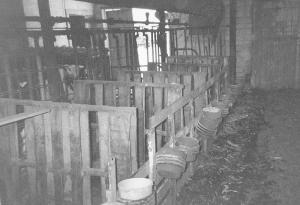Pallet Crates Helped Expand Herd
 ✖  |
When Don Bleess and Steve Smith, Blue Earth, Minnesota, decided they needed to increase the number of steers going through their feedlot, they decided their most economic source of calves would be the numerous dairy calves readily available in their local area.
Problem was, they had to buy them at 3 to 4 days of age. Besides the work of feeding young calves, they needed a place to raise them.
Bleess no longer milked cows, but had an old stanchion dairy barn. They removed the stanchions from one side of the barn and built some low-cost crates out of 4-ft. sq. wood pallets.
"We got the pallets free from a local company just for hauling them away," Bleess tells.
To turn pallets into crates, Bleess and Smith first attached a 2 by 4 flat on the wall about 3 ft. high, the full length of the barn. Then they screwed pallets to the 2 by 4 about every 3 1/2 ft. These form the sidewalls of the crates.
Toward the center alley, they attached 2-ft. high plywood fronts at the bottoms of the pallet sidewalls. One 4 by 8-ft. sheet of plywood is enough to make fronts for four crates.
A 1 by 2-in. board runs across the tops of the pallets above the plywood front. "This keeps calves from getting over the plywood and also adds stability to the crates," Bleess says.
Attached to the plywood front are two 5-in. lengths of plastic field tile, just the right diameter to hold 5-qt. plastic pails. One pail is used for milk replacer; the other for dry feed.
He says the pallet crates were simple and easy to make. "We did the whole barn - 20 crates - in about an hour," he says. "We used drywall screws, driven by an electric screwdriver, to attach everything."
Contact: FARM SHOW Followup, Don Bleess, 8186 377th Ave., Blue Earth, Minn. 56013 (ph 507 526-5274).

Click here to download page story appeared in.
Click here to read entire issue
Pallet Crates Helped Expand Herd LIVESTOCK Beef 26-2-27 When Don Bleess and Steve Smith, Blue Earth, Minnesota, decided they needed to increase the number of steers going through their feedlot, they decided their most economic source of calves would be the numerous dairy calves readily available in their local area.
Problem was, they had to buy them at 3 to 4 days of age. Besides the work of feeding young calves, they needed a place to raise them.
Bleess no longer milked cows, but had an old stanchion dairy barn. They removed the stanchions from one side of the barn and built some low-cost crates out of 4-ft. sq. wood pallets.
"We got the pallets free from a local company just for hauling them away," Bleess tells.
To turn pallets into crates, Bleess and Smith first attached a 2 by 4 flat on the wall about 3 ft. high, the full length of the barn. Then they screwed pallets to the 2 by 4 about every 3 1/2 ft. These form the sidewalls of the crates.
Toward the center alley, they attached 2-ft. high plywood fronts at the bottoms of the pallet sidewalls. One 4 by 8-ft. sheet of plywood is enough to make fronts for four crates.
A 1 by 2-in. board runs across the tops of the pallets above the plywood front. "This keeps calves from getting over the plywood and also adds stability to the crates," Bleess says.
Attached to the plywood front are two 5-in. lengths of plastic field tile, just the right diameter to hold 5-qt. plastic pails. One pail is used for milk replacer; the other for dry feed.
He says the pallet crates were simple and easy to make. "We did the whole barn - 20 crates - in about an hour," he says. "We used drywall screws, driven by an electric screwdriver, to attach everything."
Contact: FARM SHOW Followup, Don Bleess, 8186 377th Ave., Blue Earth, Minn. 56013 (ph 507 526-5274).
To read the rest of this story, download this issue below or click
here to register with your account number.







